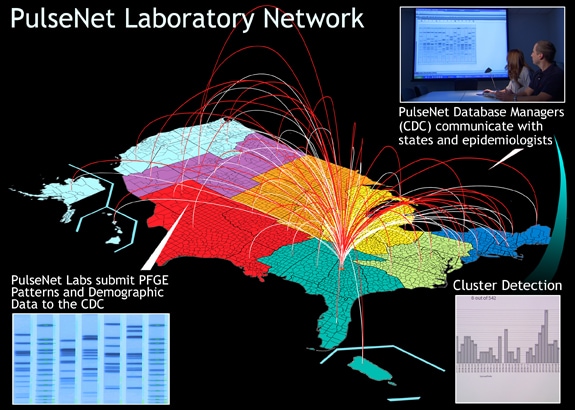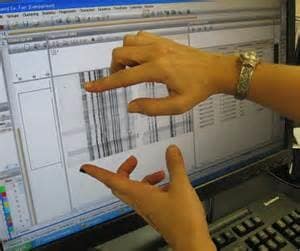Outbreak Detection
PulseNet: Often the first step in identifying a widespread foodborne outbreak

PulseNet laboratorians from across the nation submit DNA fingerprints of bacteria from sick patients to CDC. When fingerprints are matched, investigations may be launched to detect the source of the illnesses
PulseNet Detects Outbreaks

The PulseNet team at CDC compares fingerprint data submitted from across the country.
- PulseNet is a network of local, state, and federal public health laboratories that can analyze DNA fingerprints of bacteria to quickly detect a foodborne illness that otherwise might have gone undetected.
- PulseNet laboratories use pulsed-field gel electrophoresis (PFGE) to detect DNA fingerprints as well as whole genome sequencing (WGS), a newer method that provides the most accurate bacterial fingerprinting data possible today.
- Scientists can study these DNA fingerprints and post their findings on the PulseNet message board so that laboratories across the country are aware of their findings.
Not Just Food
In addition to foodborne outbreaks, PulseNet has also identified outbreaks cause by bacteria from pet turtles, hedgehogs, animals at petting zoos, rodents, reptiles, animal feed, and recreational water such as lakes, pools, streams.
PulseNet Participants’ Role
State, local, or federal laboratories analyze data generated in real time using DNA fingerprinting. Public health microbiologists enter this information into an electronic database and submit the data immediately to CDC.
PulseNet at CDC
- CDC’s PulseNet team compares fingerprint data submitted from across the country. They look for groups of matching patterns (clusters) that are increasing more now than in the past. By monitoring trends in DNA fingerprints or patterns, the PulseNet team can rapidly identify increases in reported illnesses from across the United States and trigger an investigation.
- Epidemiologists investigate illness clusters identified by PulseNet. If they find links between cases, the cluster is classified as an outbreak. The results are reported to the laboratories that submitted the patterns and posted to the PulseNet message board.
- Whole genome sequencing will replace PFGE in coming years. Whole genome sequencing provides the most accurate bacterial fingerprinting data possible today.
PulseNet rapidly identifies potential outbreaks through cluster detection. The goals of PulseNet are to provide real-time surveillance of bacterial foodborne diseases and assist epidemiologists in investigating outbreaks. PulseNet also provides a rapid and effective means of communication between public health laboratories. Learn More